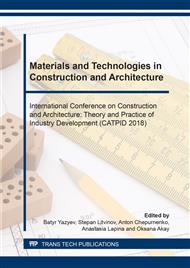p.178
p.184
p.188
p.196
p.200
p.209
p.214
p.219
p.226
Strain Analysis of Supporting Profile Vulcanizing Press
Abstract:
The article is devoted research of process equipment in the simulation of the stress-strain state of load-bearing elements in the environment of ANSYS. The obtained results are consistent with the data of preliminary calculations and confirm the performance of device. The device for connecting the ends of a conveyor fabric-rubber belt by a vulcanization method is a set of ten segments. At the stage of preliminary calculation stress-strain properties of supporting profiles vulcanizing press were determined by using SCAD software. Point load of hydraulic cylinders is transmitted on profiles in accordance with terms of reference. Strength calculation supporting profile in ANSYS software was carried out using Finite Element Method. The segment of the device under consideration is symmetrical with respect to two planes. Therefore, it was decided to simplify the calculation model using the capabilities of the ANSYS software, namely using the "Symmetry" modifier. This simplification reduces the requirements for computing power of the computer, which, in turn, allows to build a better mesh. Mesh is constructed mainly from eight-node volumetric elements of regular shape. Analysis of the supporting profile in ANSYS software confirmed the results of preliminary settlements. There are stresses in the dangerous sections of the upper profile exceeding the yield point. Despite this, during unloading, residual deformations in the profile are absent, since for the most part of the profile length in the sections there is no limiting state, that is, the stresses do not reach the yield point.
Info:
Periodical:
Pages:
200-206
Citation:
Online since:
September 2018
Price:
Сopyright:
© 2018 Trans Tech Publications Ltd. All Rights Reserved
Share:
Citation:


